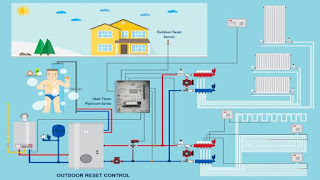What are Weather Activated Heating Controls?

Large heating systems for multi-unit or commercial buildings are designed to heat the building, and then keep temperatures as close to the set-point as possible. To do this using the least amount of energy possible maintaining heating system efficiency is key. Energy efficiency guarantees that the heating system will use the least amount of energy while keeping the building and all its tenants comfortable. Since the amount of heat a building loses to the outside changes considerably as the outdoor conditions change, it makes sense that the heating system should adjust as well. Weather activated heating controls adjust how a heating system functions to meet the heating demands of a building in the most efficient manner possible. Outdoor Air Reset (Outdoor Reset Controls) The most widely used weather activated heating control is commonly known as “Outdoor Reset”. Outdoor reset is really just a sensor that monitors the outside temperature as a way of adjusting the boiler se...

